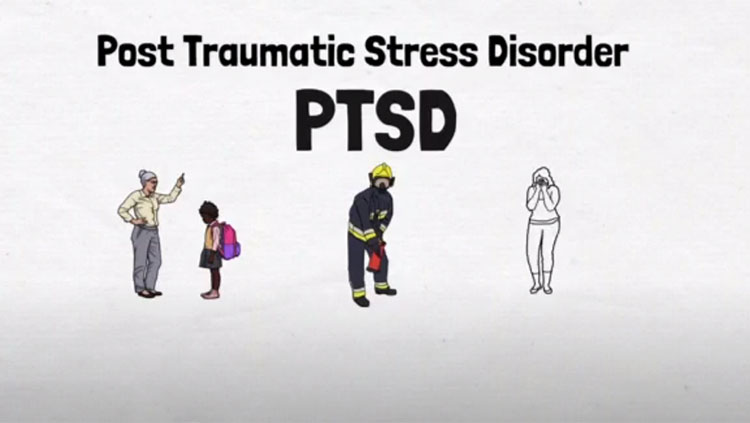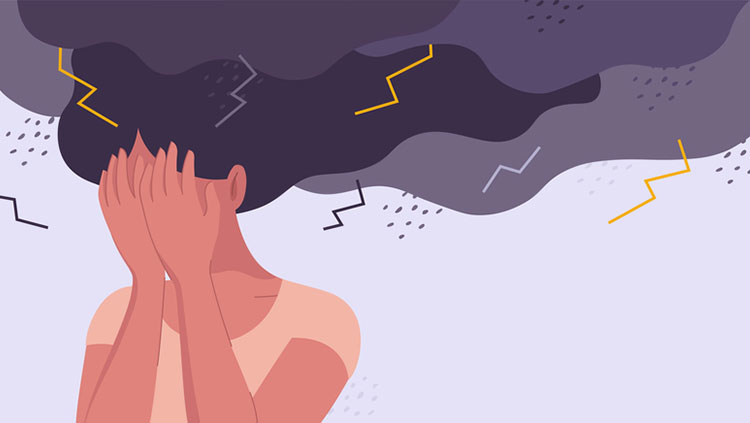Bipolar Disorder: An Overview
- Reviewed25 May 2023
- Author Alison Davis
- Source BrainFacts/SfN

People have good weeks and bad weeks, which is sometimes reflected in our mood. But for people with bipolar disorder, episodes of moods can vary between extreme highs and longer, drastic lows.
Bipolar disorder, formerly called manic-depressive illness, is marked by very intense mood changes, each period lasting anywhere from a few days to several months. High, or manic, episodes involve boundless energy, racing thoughts, and insomnia; they may also involve substance abuse and harmful behaviors like risky sex or other unsafe activities. During low, or depressive, episodes, people with bipolar disorder feel very sad, hopeless, and worried. Suicide risk is elevated during both manic and depressive episodes. Some individuals with bipolar disorder experience a less severe form of mania called hypomania; they may be highly productive, feel great, and function better than normal. This experience may be outwardly subtle — only noticed by a friend or family member — but can hint at a more intense mania in development.
Diagnosis for bipolar disorder is often missed or delayed. No specific tests, other than a set of symptoms medical professionals use, differentiate it from other psychiatric disorders such as depression, psychosis, or schizophrenia. Researchers don’t understand what causes bipolar disorder, although many individuals have a family history of mood disorders or psychotic illness. Some people with depression may be at higher risk for bipolar disorder if a relative has autism or a psychiatric illness like has bipolar disorder or schizophrenia. Studies analyzing the genomes of thousands of people with diseases like bipolar disorder have identified genetic changes that appear to be involved, but more research is needed to understand how and why these genetic differences lead to the disorder.
For some, but not all, treatment can be difficult. Psychiatrists typically prescribe separate drugs to stabilize mood. Medications such as anti-epilepsy drugs, lithium, or so-called atypical antipsychotics are used for manic periods, and antidepressants or cognitive behavioral therapy during depressed periods.
Adapted from the 8th edition of Brain Facts by Alison Davis.
If you or someone you know in the U.S. is struggling with self-harm or thoughts of suicide, visit or call the National Suicide Prevention Lifeline at 988 or 1-800-273-8255.
CONTENT PROVIDED BY
BrainFacts/SfN
References
American Psychiatric Association. (2023). Diagnostic and Statistical Manual of Mental Disorders (5th ed., text rev.). https://doi.org/10.1176/appi.books.9780890425787
Bandelow, B., & Michaelis, S. (2015). Epidemiology of anxiety disorders in the 21st century. Dialogues in Cclinical Nneuroscience, 17(3), 327–335. https://doi.org/10.31887/DCNS.2015.17.3/bbandelow
Burguière, E., Monteiro, P., Mallet, L., Feng, G., & Graybiel, A. M. (2015). Striatal circuits, habits, and implications for obsessive-compulsive disorder. Current Oopinion in Nneurobiology, 30, 59–65. https://doi.org/10.1016/j.conb.2014.08.008
Craddock, N., & Sklar, P. (2013). Genetics of bipolar disorder. Lancet (London, England), 381(9878), 1654–1662. https://doi.org/10.1016/S0140-6736(13)60855-7
Foland-Ross, L. C., Hamilton, P., Sacchet, M. D., Furman, D. J., Sherdell, L., & Gotlib, I. H. (2014). Activation of the medial prefrontal and posterior cingulate cortex during encoding of negative material predicts symptom worsening in major depression. Neuroreport, 25(5), 324–329. https://doi.org/10.1097/WNR.0000000000000095
Geddes, J. R., & Miklowitz, D. J. (2013). Treatment of bipolar disorder. Lancet (London, England), 381(9878), 1672–1682. https://doi.org/10.1016/S0140-6736(13)60857-0
Kavanagh, D. H., Tansey, K. E., O'Donovan, M. C., & Owen, M. J. (2015). Schizophrenia genetics: emerging themes for a complex disorder. Molecular Ppsychiatry, 20(1), 72–76. https://doi.org/10.1038/mp.2014.148
Memon, M. A. (2018). Panic Disorder. Medscape. http://emedicine.medscape.com/article/287913-overview
National Alliance on Mental Illness. (2017). Depression. https://www.nami.org/Learn-More/Mental-Health-Conditions/Depression
National Institute of Mental Health. (2017). Anxiety Disorders. NIH. https://www.nimh.nih.gov/health/topics/anxiety-disorders/index.shtml
National Institute of Mental Health. (2017). Bipolar Disorder. NIH. https://www.nimh.nih.gov/health/statistics/prevalence/bipolar-disorder-among-adults.shtml
National Institute of Mental Health. (2017). Depression. NIH. https://www.nimh.nih.gov/health/topics/depression/index.shtml
National Institute of Mental Health. (2017). Obsessive-Compulsive Disorder (OCD). NIH. https://www.nimh.nih.gov/health/topics/obsessive-compulsive-disorder-ocd/index.shtml
National Institute of Mental Health. (2017). Panic Disorder. NIH. https://www.nimh.nih.gov/health/statistics/prevalence/panic-disorder-among-adults.shtml
National Institute of Mental Health. (2017). Post-Traumatic Stress Disorder (PTSD). NIH. https://www.nimh.nih.gov/health/statistics/prevalence/post-traumatic-stress-disorder-among-adults.shtml
Pittenger, C., & Bloch, M. H. (2014). Pharmacological treatment of obsessive-compulsive disorder. The Psychiatric Cclinics of North America, 37(3), 375–391. https://doi.org/10.1016/j.psc.2014.05.006
Ragen, B. J., Seidel, J., Chollak, C., Pietrzak, R. H., & Neumeister, A. (2015). Investigational drugs under development for the treatment of PTSD. Expert Opinion on Investigational Drugs, 24(5), 659–672. https://doi.org/10.1517/13543784.2015.1020109
Strube, W., Bunse, T., Nitsche, M. A., Wobrock, T., Aborowa, R., Misewitsch, K., Herrmann, M., Falkai, P., & Hasan, A. (2015). Smoking restores impaired LTD-like plasticity in schizophrenia: a transcranial direct current stimulation study. Neuropsychopharmacology, 40(4), 822–830. https://doi.org/10.1038/npp.2014.275
Treadway, M. T., Waskom, M. L., Dillon, D. G., Holmes, A. J., Park, M. T. M., Chakravarty, M. M., Dutra, S. J., Polli, F. E., Iosifescu, D. V., Fava, M., Gabrieli, J. D. E., & Pizzagalli, D. A. (2015). Illness progression, recent stress, and morphometry of hippocampal subfields and medial prefrontal cortex in major depression. Biological Psychiatry, 77(3), 285–294. https://doi.org/10.1016/j.biopsych.2014.06.018
U.S. Department of Veterans Affairs. (2023). PTSD: National Center for PTSD. https://www.ptsd.va.gov/understand/common/common_adults.asp
World Health Organization. (2022). Mental disorders. https://www.who.int/news-room/fact-sheets/detail/mental-disorders



















